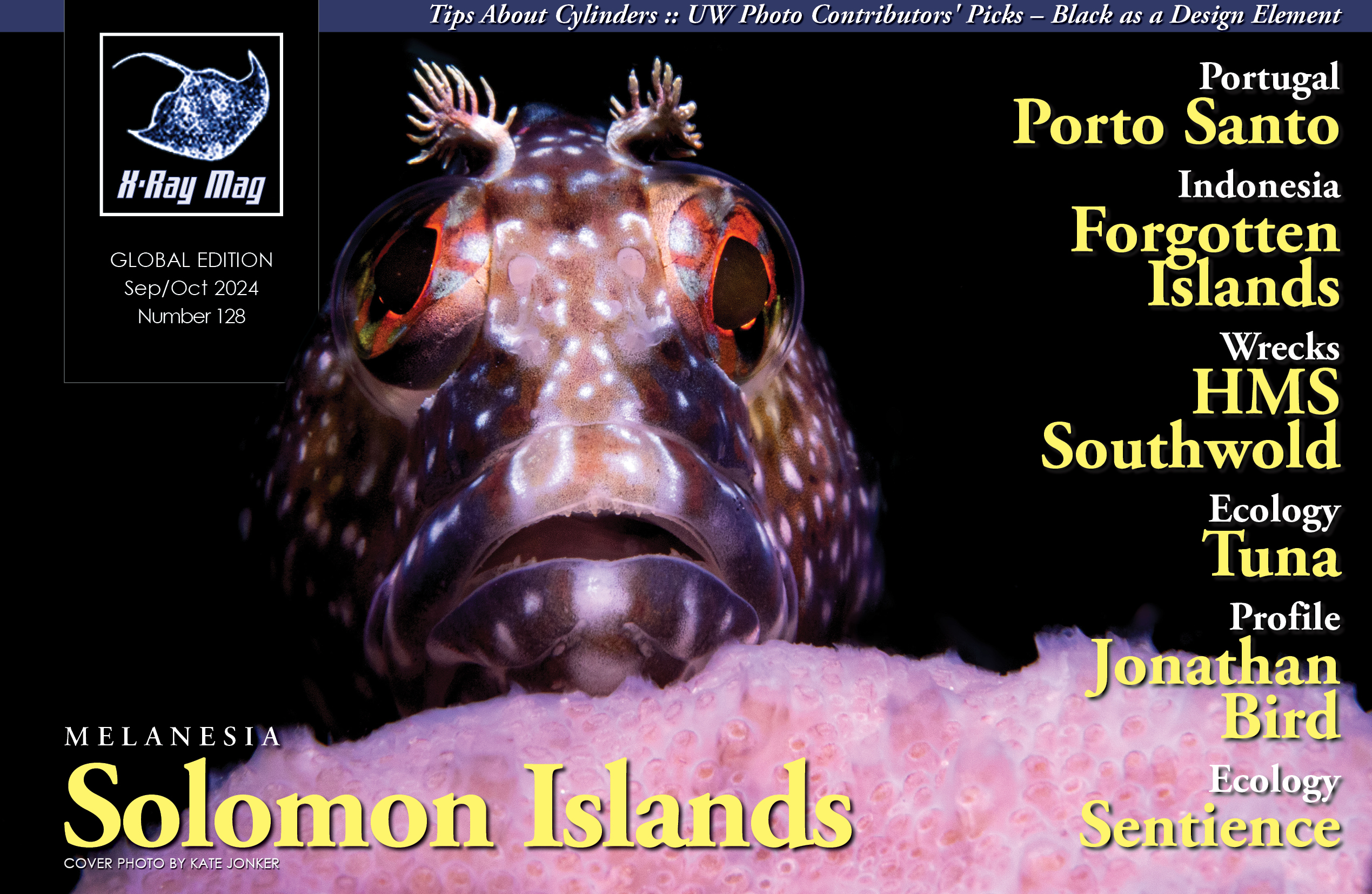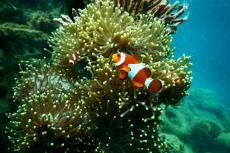We asked our contributors to share their favorite underwater images that use black as a design element, and they came back with a dynamic selection of macro and wide-angle shots featuring a diverse range of marine life, haunting wreck scenes, dramatic underwater topography, and even divers.
Contributed by
Here, X-Ray Mag contributors share their selected images from the tropical waters of Fiji, the Solomon Islands, Chuuk, Papua New Guinea, the Philippines, Indonesia, the Maldives, the Red Sea, the Turks and Caicos Islands, Mexico and Hawaii to the subtropical and temperate waters of Florida, the US East Coast, Canada and South Africa.
(To see all the images in this article, please scroll down to the end and download the PDF.)
The Strategic Use of Black
Text and photos by Kate Jonker
Incorporating black in underwater photography can dramatically enhance and emphasise the colours, details and textures of your subjects. The contrast created by black not only makes vibrant colours pop but also adds depth and dimension to your images. For instance, using the silhouette of a reef or wreck against brightly coloured soft corals on the reef can create a striking visual impact. This method not only highlights the vivid hues but also brings out the intricate textures and details of marine life.
Another effective technique is inward lighting with strobes or torches, which allows you to spotlight your subject against a dark water column. This approach isolates the subject, making it stand out against a black background, thus drawing the viewer’s attention to the subject’s colours and details. Similarly, using a snoot can create a focused pool of light on a vibrant subject, separating it from a potentially distracting background. This targeted lighting enhances the subject’s natural beauty, making the colours more vivid and the textures more pronounced.
In my own work, I have found that the strategic use of black can transform an ordinary photo into an extraordinary one. By carefully balancing light and shadow and using black as a contrasting element, the true beauty of the underwater world is revealed in stunning detail and vibrant colour. This technique not only showcases the splendour of marine life but also adds a professional touch to underwater photography. Visit: katejonker.com

Black Composition
Text and photos by John A. Ares
Black is a feature that helps frame divers. The dive site in Photo 1 is a famous drop-off at Apo Island. The image is a happy accident because as I was photographing the diver with the camera, the others just happened to swim into the frame.
Black can be significant as negative space, but here in Photo 2, the black color is a key component of the nudibranch. Jorunna funebris is a species of nudibranch that can grow quite large.
The theme for this feature was the use of black as a key component in a color photo. While the original blue version of the great white shark in Photo 3 makes for a strong image, I believe the pure black and white version of it in Photo 4 is stronger.
I used Nik Silver Efex Pro to convert the full-color photo to black and white. Photos can become more artistic by removing some of the reality. The black can be made darker without looking artificial, making the image more dramatic. Visit: JohnAres.com
Resource: Hanlon RT, Messenger JB. 1996. Cephalopod Behavior. Cambridge University Press.

Making Subjects Stand Out
Text and photos by Sheryl Checkman
Black, when used to isolate a subject, can make for a very dramatic photograph. In each of the four photos I chose for this theme, the subject stands out from the background simply because the background has been rendered black, making the color pop. I chose to silhouette a close-up of a spadefish at Blue Heron Bridge in Florida (Photo 1) by making the background black. Had I not done so, the fish’s mostly silvery white body would have been lost against the sandy bottom.
In Photo 2, the black background behind an orange brittle star spread out on a yellow gorgonian at Fifi, off French Cay in Turks and Caicos, nicely isolates the gorgonian and lets the eye focus on the bright orange brittle star. The Christmas tree worms clinging to a coral head in Turks and Caicos in Photo 3 also stand out against the black background.
On a night dive in Alor, Indonesia, I photographed bubble coral, also known as Plerogyra sinuosa, a stony coral species (Photo 4). During the day they appear soft, with fleshy membranes (vesicles), but at night they pull in their vesicles to reveal their hard calcareous skeleton. Since this was a night dive, there was no ambient light to add color to the surrounding background. So, by using only my single strobe on the subject, I got a nice black background, highlighting the bone-like structure of the coral and revealing the tentacles it uses to capture plankton and small prey in the passing currents. The resulting image is more like an abstract work of art, with the dark negative space creating a sculptural effect. Visit: Instagram.com/SherylCheckman

Creating Dramatic Images
Text and photos by Larry Cohen
When shooting underwater, I often opt for a slow shutter speed. This technique allows me to capture a vibrant and colorful background. To enhance the details inside wrecks and caves, I occasionally use an additional strobe or LED light. However, the artifacts and machinery inside a shipwreck can take on a mysterious quality when set against a black background. The shipwrecks of Chuuk Lagoon, in particular, offer a stunning backdrop for such photography.
The interiors of wrecks are often dark, making it challenging to capture the details of the subject. To overcome this, I employ two strobes to effectively light the subject while a fast shutter speed ensures a black background. This setup also prevents my focus light from showing up in the photograph. I used this lighting scheme inside the Fujikawa Maru to photograph a gas mask on some machinery, creating a dramatic image.
Many of the ships sunk in Chuuk are freighters. Their cargo, once intended to help the Japanese war effort, now rests permanently on the bottom of the lagoon inside the wrecks. In the cargo holds of the Hoki Maru, there are truck parts that never made it to their destination. Photographing the front grills from a low angle gives them a majestic appearance, underscoring the importance of preserving the history of these shipwrecks.
Inside the San Francisco Maru, there are many intact trucks. Photographing one of the trucks from a low angle, I used a shutter speed of 1/60th of a second to capture a hint of blue light from the wreck’s openings. I also found porcelain tableware used by the crew inside the San Francisco. I used side lighting to highlight the details and to keep the background black, emphasizing the awe-inspiring presence of these intact artifacts. Visit: liquidimagesuw.com

Spotlighting Subjects
Text and photos by Lureen Ferretti
Black, the result of the absence of light, is often used in underwater photography to draw the viewer’s attention to the primary subject, in the same way a spotlight is used on key characters in Broadway performances. Often, we find the most beautiful subjects blending in well with their cluttered, busy backgrounds, making it difficult to make the subject stand out.
Clever photographers have learned to isolate their subjects by using snoots. Snoots are special strobes or strobes with attachments to adjust the light beam. Snoots are quite possibly one of the most frustrating gadgets to learn how to use efficiently and effectively to change the size and shape of the light beam to blacken the background with just the lighting—often referred to as making the subject “pop.” Visit: instagram.com/lureenferrettiphotography

Black Magic in a Color Image
Text and photos by Anita George-Ares, PhD
In Photo 1, a porcelain crab is resting at the base of an anemone. Porcelain crabs have a pair of appendages covered with long bristles. The black negative space highlights the long bristles used for filtering plankton.
Soft corals are abundant in the Red Sea and come in a variety of colors. The black negative space in Photo 2 intensifies the orange and pink colors of the soft corals and the anthias.
I was making a late afternoon dive at Ali Thila in the Maldives when it began to get dark underwater. I encountered a juvenile hawksbill sea turtle as it slowly ascended toward the surface (Photo 3). The black background isolates the turtle and highlights the scale patterns on its head and flippers. Some of the beautiful shell pattern shows through the encrustations.
During a night dive at Alimatha in the Maldives, I captured the image of a tawny nurse shark (Photo 4). The black background and the white sand highlight the pinkish-brown shark. Alimatha is known for its abundance of tawny nurse sharks. Bait that is routinely placed in the area attracts the sharks. Visit: facebook.com/profile.php?id=100016947967639

The Many Uses of Black
Text and photos by Matthew Meier
Black can be used to isolate a colorful subject, eliminate a distracting background, provide an additional point of interest and scale with a diver silhouette, and also define an underwater structure. The first two examples involve lighting techniques that use snoots and/or strobe positioning to keep light from hitting the area behind what is being photographed. In combination with low ISO levels, fast shutter speeds and typically small apertures, the resulting effect, when done properly, is a colorful critter in front of a black canvas.
A diver in silhouette above a colorful scene helps move the viewer’s eye around the frame. Our eyes are drawn to the contrast of the black human form against the negative space. The diver’s silhouette also adds a known proportion to assess the scope of the setting.
Underwater formations—whether hard coral arrangements, old lava tubes or caverns—often have fabulous shapes that can be emphasized by exposing for the light that shines through their openings while providing no additional lighting. This allows the walls to go black, defining their parameters. While I am certain there are many other creative ways to use black in color images, these photos illustrate each of the above techniques. Visit: MatthewMeierPhoto.com

Exposure: ISO 200, f/18, 1/200s.
Fish in Black
Text and photos by Brandi Mueller
I love using black backgrounds to accentuate fish. Removing all or most of the distractions of the reef behind them helps the fish stand out. It also shows the fish in a slightly different manner than with the blue background of the water they live in. By underexposing the image and using strobes positioned in different ways to light only certain parts of the subject, it is fun and challenging to make an image with a black background.
The Philippines has an abundance of fish life, so it is a great location to try different techniques when shooting fish. A goby sits on an outer ridge of a barrel sponge, allowing the light to only fall on those parts of the sponge, leaving the crevasses black. A hawkfish also perches on a barrel sponge. A golden damselfish tries to look ferocious while guarding its eggs, and an ameonefish opens its mouth to be cleaned by a wrasse. Visit: brandiunderwater.com

A Splash of Black — A Splash of Color
Text and photos by Gary Rose, MD
I often enjoy using subtle coloring to emphasize the feelings I experience when I witness the beauty and majesty within the sea. I have also found that on many occasions, when I combine muted coloring with black, I am able to add an additional layer of visual information that augments the successful capture of the emotion I felt at the exact moment I witnessed the scene. Later, when viewing my photos, the nuances of color and black evoke the same feelings and responses I experienced when I originally took the photo.
I utilize soft colors to magnify what I feel at the very instant I capture a silhouette. In Photo 1, the entire photo tells a story. The soft greens merging into soft blues, a little bit of copper reflection on the baitfish and the cathedral lighting demonstrate the ethereal warmth of an oceanic sunset. The black silhouette of the great white shark slowly disappearing into the curtain of subtle color adds to the feeling of witnessing a very special moment.
One of the pleasures of diving off Jupiter in Florida is the opportunity to dive with the resident community of lemon sharks. I love watching them cavort and play as I ascend to my safety stop. By experimenting with my settings (depending on the lighting conditions of the day), I have captured some wondrous moments. In Photo 2, the inky black background serves as a backdrop that emphasizes the subtle shade gradient in the coloring of these energetic lemon sharks, creating an X-Y-Z dimensionality—a depth of field. When I took this photo and when I look at it today, I still feel myself pulled into the game these “puppy dogs” were playing.
One of the bucket list items for underwater photographers is to capture the wide-open jaws of a shark. Lemon sharks are particularly excellent for photographs with their jaws wide open. Their numerous sharp, needle-like teeth add an extra layer of excitement. In Photo 3, the black negative space (empty background) offers a canvas that immediately draws the viewer’s attention to this “dental dream”. In addition, the very pale pink of the shark’s gums and the light beige of her gullet evoke a primal fear of terror in the night.
Speaking of primal fear, there is another shark that many people associate with human-shark interactions, and unfortunately not in a positive manner. Tiger sharks are beautiful, intelligent and curious. It is their inquisitiveness that initiates most human-tiger shark encounters. Photo 4 demonstrates the beauty of the bars and bands on a large female tiger shark. To feature and accentuate the very subtle pinks and blues of her otherwise metallic silver skin, I dusted her with my strobe lights (on a very low setting) against a very dark black background.
I was once told that to become a reasonably good photographer, all that it took was to push the shutter release, push again and keep pushing. I would add to that advice: Be willing to experiment, using subtle coloring and black, and let the light guide you… Click away. Please visit: garyrosephotos.com

Black in Color Images
Text and photos by Michael Rothschild, MD
As automaker Henry Ford may or may not have said about his cars, “You can have any color you want as long as it’s black.” Divers—especially technical divers—have long had a similar choice. And while manufacturers are now throwing splashes of color into their gear, black still dominates the market. This presents a challenge for photographers hoping to show some of the detail in their models’ kit, ever battling the tonal range on the left side of the histogram.
In Photo 1, the diver’s gaze is fixed on the photographer as he finishes his decompression stop, perfectly poised in the water column. His suit and rebreather are all in technical black, but both AP Diving and Fourth Element have thrown a bit of yellow into the scene, which contrasts nicely with the rich blue of the shallow Pacific in the background. Photo 2 also shows a technical diver, this time in the frigid waters of Newfoundland. In his black gear with yellow accents, he drifts up out of the black void of the hold below. In Photo 3, the jet-black pupil of the clownfish lurks behind the venomous tentacles of its symbiotic friend, the sea anemone, like a portal to another dimension. And Photo 4 shows another diver in Canada, again wearing black with yellow accents, surfacing in the cool green of the St. Lawrence Seaway. Visit: dive.rothschilddesign.com

Elements of Black
Text and photos by Olga Torrey
The elegant black and white-edged ruffled mantle of the ornate leaf slug defines its aesthetic beauty in Photo 1. Black and white, used together, create a stark contrast that is visually compelling, defining black as the color of sophistication and white as the color of purity, emphasizing exciting shapes and forms. This sea slug is a sacoglossan, which feeds on green algae.
In Photo 2, the red color of the coral pops with vibrant intensity, and the black background intensifies the depth. These two colors attract attention by creating a visual dynamism with a bold and dramatic atmosphere. Red corals feed on zooplankton or derive their nutrition from zooxanthellae.
My visit to Kailua-Kona, Hawaii, was the adventure of a lifetime. I embarked on a thrilling night-snorkeling experience with giant oceanic manta rays.
To focus on the vivid details of the mantas’ black skin and the white patches on their bodies floating against the solid black background of the water, I used lights to attract plankton and spotlight the manta rays (Photo 3). The use of video lights as an essential tool helped my artistic vision to show the strength, power and mystery of the manta rays while leaving the rest aside. The animals were hungry and active, giving me plenty of opportunities to capture them in action with their graceful, acrobatic movements. The giant oceanic manta ray feeds on small fish, crustaceans and zooplankton. Visit: fitimage.nyc
Reference: wikipedia.org































